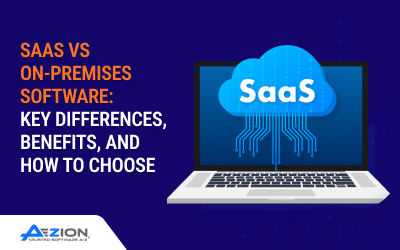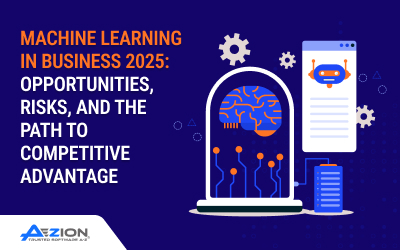Summary
The Stages of Business Intelligence explain how raw data is converted into actionable insights for better decision-making. In this blog post, we will explore each stage involved in the BI lifecycle from data collection to decision-making to help businesses gain value from data. We also explain the major Features of Business Intelligence tools, key benefits, practical use cases, and industry-specific applications. Finally, the content highlights relevant Data Engineering Solutions that support modern BI initiatives.
Introduction
Modern businesses grow on data-based decisions, and understanding the Stages of Business Intelligence is helps get real-time insights. Business Intelligence helps business owners collect, process, and visualize data. According to the recent reports, the business intelligence market size is expected to Reach USD 54.27 Billion, at a 9.1% CAGR by 2030. As competition increases across industries, knowing how BI works allows leaders to stay agile and informed. This blog walks you through the Business Intelligence Stages, explains their value, and explores tools and use cases that help transform raw data into strategic action.
What is Business Intelligence?
Business Intelligence or BI is a set of tools, systems, and strategies that business owners use to convert raw data into relevant information. The information supports timely and effective decision-making across departments. The Business Intelligence Stages involve everything from data extraction to visualization, helping companies understand patterns, trends, and performance indicators. BI is important in improving operations, customer engagement, and profitability by making sense of complex datasets.
Key Capabilities of Business Intelligence Tools
Before we jump into the functionalities of each, it is important to understand how the modern Business Intelligence platforms work. The tools simplify data handling, streamline analysis, and give insights in a manner that is easy to interpret. Every feature helps improve decision making across Phases of Business Intelligence. Here are a few reasons that make these tools powerful and user-friendly.
- Hierarchal Data Organization: The feature helps users to structure data in a layered format, making it easier to separate into categories and subcategories. It supports a more detailed understanding of business performance with a clear view of data relationships.
- Drag-And-Drop Interface: The setup lets users build dashboards and reports without technical skills. It removes complexity from report generation and helps teams across departments assess data quickly.
- Data Aggregation: It collects and summarizes large information from different sources to identify trends and make comparisons in the Business Intelligence Phases to help with better decision making.
- Data Filters: It helps users to separate data sets as per timeframes, regions, departments or other variables. It gives clarity and helps business owners to focus on the relevant information based on the role.
Benefits of Business Intelligence
Business Intelligence increases organizational efficiency by turning raw data into practical insights. As businesses scale, using the Stages of Business Intelligence can support better outcomes across departments. Here are key benefits of using Business Intelligence in your daily operations:
- Decision-Making: BI gives real-time dashboards and reports to help managers make quick and data-based decisions that increases revenue and efficiency.
- Operations Efficiency: BI tools identify issues and performance gaps, helping companies to simplify processes across different functions for smoother functions.
- Competitive Advantage: The market trends, customer behavior, and internal performance analysis help companies track competition and stay ahead.
- Forecasting Accuracy: Using historical and current data, Business Intelligence platforms offer better predictions and proactive planning.
- Collaboration: Data transparency across teams leads to more aligned strategies and smoother cross-functional communication.
6 Stages of Business Intelligence
The stages of business intelligence give a process from which the data is converted into valuable insights. Every phase is important to build a scalable and intelligent data strategy that supports operational efficiency and long-term business growth.
Data Collection
It is the first stage where business owners collect data from internal systems like CRMs, ERPs, financial platforms and external sources like market feeds and customer surveys. Timely and accurate data collection builds the ground for the other Business Intelligence Stages to help organizations maintain accuracy and relevancy.
Data Preparation
Raw data often contains inconsistencies, duplicates, or irrelevant entries. It is the phase where the data is cleaned, formatted, categorized, and checked if it is fit for analysis. The stage improves quality inputs, helps in the overall success of the phases of business intelligence.
Data Storage
Clean and structured data is then stored securely in repositories like data warehouses or cloud-based lakes. Proper storage allows fast and organized access when needed. At this point, businesses begin to implement supporting infrastructure that often includes robust Data Engineering Solutions for scalability and performance.
Data Analysis
This is where meaningful patterns and correlations are extracted using analytical tools and techniques. It allows teams to interpret business performance, customer behavior, and market dynamics. As part of the Business Intelligence Phases, this step directly supports informed planning and strategy development.
Data Visualization
It is difficult to interpret raw numbers. Third-party data visualization tools convert the data into charts, dashboards, and heatmaps that are simple to understand. The step give clarity to data, helping teams to spot trends, highlight risks, and present information to business owners in an easy-to-understand visual manner.
Decision Making
In the last step, the insights are turned into action. Using the results, from every stage, business owners improve strategies, reallocate resources, and start new initiatives based on data. The process promotes smarter and data-based decisions across organizations.
Importance of Business Intelligence
Understanding the Business Intelligence Stages helps organizations shift from reactive decision-making to a proactive, insight-driven approach. Below are the key reasons why BI is considered essential in today’s data-centric world:
- Better Strategic Planning: With accurate data in hand, leadership teams can set more precise goals and align resources accordingly.
- Data-Driven Culture: Teams under every department get the confidence to act based on insights rather than assumptions.
- Improved Market Response: Business Intelligence tools give faster analysis of external and internal changes for better business decisions.
- Reduced Operational Risk: Clear insights from data reduce the possibility of errors and inefficiencies, for better cost decisions.
- Continuous Improvement: Each stage in the BI-cycle promotes learning, adjustment, and refinement over time.
Business Intelligence Use Cases
Business Intelligence offers flexible applications across multiple functions and industries. Organizations can get better results, reduce inefficiencies, and make better decisions by following the proper channels for Business Intelligence Stages. Below are key use cases where BI delivers measurable value.
BI for Finance
Finance teams use BI to track expenses, monitor revenue, forecast cash flow, and analyze profitability trends. It supports smarter budgeting and risk assessment by providing accurate, real-time visibility into financial operations across all Phases of Business Intelligence.
BI for Marketing
BI enables marketing teams to evaluate campaign performance, audience engagement, and customer journeys. With advanced segmentation and reporting, it becomes easier to fine-tune targeting, boost ROI, and align marketing strategies with the Stages of Business Intelligence for data-driven outcomes.
BI for Sales
Sales departments apply BI tools to assess pipeline health, monitor quotas, and track customer behavior. It helps managers identify top-performing products, optimize pricing, and allocate resources based on timely, insight-driven data gathered through each Stage of Business Intelligence.
BI in Healthcare
In healthcare, BI manages patient records, simplifies operations, and monitor treatment outcomes. The real-time dashboards improve care quality, resource planning, and regulatory compliance all guided by the Business Intelligence Phases.
BI in Operations
Operational teams rely on BI to monitor supply levels, workflow efficiency, and turnaround times. These insights help reduce downtime, improve productivity, and strengthen service delivery across the business using structured Business Intelligence Stages.
BI in Supply Chain
BI improves procurement, logistics, inventory, and vendor performance. BI in Supply Chain finds delays, reduces cost, and enhances delivery accuracy. Data collected and analyzed through these stages supports better planning and execution in complex supply chain environments.
Challenges of Business Intelligence
While Business Intelligence offers powerful advantages, implementing it effectively can present various obstacles. Being cautious of the challenges helps businesses go through every Business Intelligence Stage with clarity, avoiding issues that affect value generation from data.
- Data Quality Issues: Inconsistent, outdated, or incomplete data affects BI insights. Businesses should focus on high-quality input across all Phases of Business Intelligence to support reliable outcomes.
- Integration Complexity: BI tools often need to connect with various data sources, including legacy systems. Integration challenges can slow down the implementation process and limit access to critical business information.
- User Adoption Resistance: Not all employees may be comfortable using BI tools. Without proper training and change management, businesses may struggle to embed BI into daily workflows effectively.
- Data Overload: Too much data without context can overwhelm users. A well-planned strategy using the Stages of Business Intelligence is required to extract only the most relevant and actionable insights.
- Cost and Maintenance: High upfront investment and ongoing maintenance can be a barrier for small to mid-sized organizations. Selecting the right Data Engineering Solutions can help reduce long-term operational costs.
Conclusion
Mastering the Stages of Business Intelligence allows organizations to shift from instinct-based decisions to insight-driven strategies. By following each stage carefully — from data collection to decision-making businesses can unlock the full value of their information assets. Understanding the Business Intelligence Stages not only supports operational efficiency but also lays the groundwork for long-term innovation and growth. The right approach and reliable Data Engineering Solutions can help businesses create a scalable groundwork that transforms data into a strategic decision.
FAQs
What are the stages of Business Intelligence?
The Stages of Business Intelligence include data collection, preparation, storage, analysis, visualization, and decision-making. Each stage contributes to turning raw information into valuable business insights that support smarter strategies.
How do BI tools help different departments?
BI tools help in financial tracking, marketing performance analysis, operational reporting, and sales forecasting. When applied in the Business Intelligence Stages, the tools help departments make better and timely decisions.
What are the challenges of using Business Intelligence systems?
When using BI systems issues like poor data quality, tool integration issues, limited user adoption, and data overload. Following all BI phases helps organizations avoid the issues and improve outcomes.
Can small businesses benefit from BI systems?
Yes, small businesses can use BI tools to track KPIs, customer behavior, and financial performance. Even basic tools offer value when applied across the right Stages of Business Intelligence for informed growth planning.
What role do Data Engineering Solutions play in BI implementation?
Data Engineering Solutions provide the technical backbone for BI systems. They support reliable data pipelines, storage architecture, and processing workflows that help businesses gain value from every stage of the intelligence lifecycle.



